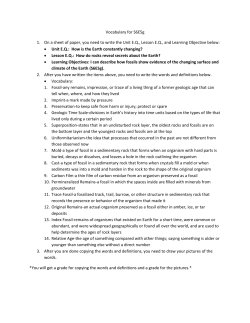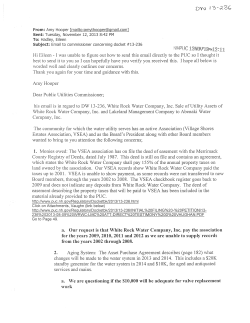
Geologic History A) appearance of the earliest
Geologic History 1. Which event occurred earliest in geologic history? A) B) C) D) appearance of the earliest grasses appearance of the earliest birds the Grenville Orogeny the intrusion of the Palisades Sill 2. When did the Jurassic Period end? A) 66 million years ago C) 163 million years ago B) 144 million years ago D) 190 million years ago 3. Studies of the rock record suggest that A) the period during which humans have existed is very brief compared to geologic time B) evidence of the existence of humans is present over much of the geologic past C) humans first appeared at the time of the intrusion of the Palisades sill D) the earliest humans lived at the same time as the dinosaurs 4. What is the estimated length of time of the Mesozoic Era? A) 65 million years C) 225 million years B) 160 million years D) 345 million years 5. Which radioactive isotope disintegrates to lead (Pb 206)? A) C 14 B) K 40 C) Rb 87 D) U 238 Geologic History 6. Radioactive carbon (C l4 ) would be especially useful in determining the age of A) B) C) D) geologically young organic remains geologically young inorganic remains Precambrian igneous rocks extremely small amounts of material 7. Which radioactive substance has the longest half-life? A) carbon-14 C) rubidium-87 B) potassium-40 D) uranium-238 8. A fossil shell contains 25% of the original amount of its carbon-14. Approximately how many years ago was this shell part of a living organism? A) 5,700 years ago C) 17,100 years ago B) 11,400 years ago D) 22,800 years ago 9. The graph below shows the radioactive decay of a 50-gram sample of a radioactive isotope. According to the graph, what is the half-life of this isotope? A) 100 years B) 150 years C) 200 years D) 300 years Geologic History 10. Evidence indicates that 251 million years ago a mass extinction of many life-forms occurred on Earth. Which form of life became extinct at this time? A) trilobites B) dinosaurs C) mammoths D) eurypterids 11. Which group of organisms has the shortest record of life on Earth? A) eurypterids C) birds B) graptolites D) placoderm fish 12. Which statement can best be supported by the fossil record? A) B) C) D) Humans have lived on Earth throughout geologic history. The organisms on Earth have not changed. Most life-forms that existed on Earth have become extinct. Dinosaurs existed on Earth for more than 544 million years. Geologic History 13. Base your answer to the following question on the graph below which shows the development, growth in population, and extinction of the six major groups of trilobites, labeled A through F. During which period did the last of these trilobite groups become extinct? A) Cretaceous C) Permian B) Triassic D) Carboniferous 14. Which life-form appeared first? A) trilobite C) coelophysis B) human D) stromatolite Geologic History Base your answers to questions 15 and 16 on the diagram below, which shows a cross section of Earth’s crust. 15. Which statement gives an accurate age relationship for the bedrock in the cross section? A) B) C) D) Intrusion A is younger than intrusion C. Intrusion C is younger than intrusion B. Intrusion B is older than intrusion A. Intrusion C is older than layer E. 16. The most apparent buried erosional surface is found between rock units A) A and B B) C and D C) D and F D) E and H Geologic History 17. The diagram below represents layers of rock. Rock layer A is inferred to be older than intrusion B because A) B) C) D) layer A is composed of sedimentary rocks parts of layer A were altered by intrusion B layer B is located between layer A and layer C parts of layer C were altered by intrusion B 18. Unless a series of sedimentary rock layers has been overturned, the bottom rock layer usually A) B) C) D) contains fossils is the oldest contains the greatest variety of minerals has the finest texture 19. Organisms that later became good index fossils lived over a A) B) C) D) wide geographic area and existed for a long geologic time wide geographic area and existed for a short geologic time limited geographic area and existed for a long geologic time limited geographic area and existed for a short geologic time Geologic History 20. Thin layers of volcanic ash act as excellent time markers in the correlation of bedrock because volcanic ash A) B) C) D) is easily eroded and lasts only a short time on Earth's surface stays in the atmosphere for millions of years is deposited over millions of years falls to Earth over a large area in a short period of time 21. According to the fossil record, which group of organisms has existed for the greatest length of time? A) gastropods C) mammals B) corals D) vascular plants 22. Shark and coral fossils are found in the rock record of certain land areas. What does the presence of these fossils indicate about those areas? A) B) C) D) They have undergone glacial deposition. They were once covered by thick vegetation. They have undergone intense metamorphism. They were once covered by shallow seas. Geologic History Base your answers to questions 23 through 26 on the geologic cross section of bedrock below. Letters A through G identify rock units and line XY represents a fault. The rocks have not been overturned. 23. Maclurites fossils are found in rock unit F. During which geologic time period were the sediments that formed rock unit F deposited? 24. What evidence indicates that the folded bedrock is older than fault line XY? 25. Identify one metamorphic rock that would likely form in layer G along igneous intrusion A. 26. On the cross section above, draw a dark line to indicate the most likely location of an unconformity. Geologic History 27. Which sequence shows the correct order of Earth’s geologic time intervals from oldest to youngest? A) B) C) D) Archean ® Mesozoic ® Cenozoic ® Paleozoic ® Proterozoic Archean ® Proterozoic ® Paleozoic ® Mesozoic ® Cenozoic Cenozoic ® Mesozoic ® Paleozoic ® Proterozoic ® Archean Cenozoic ® Paleozoic ® Archean ® Mesozoic ® Proterozoic 28. Geologists have subdivided geologic time into units based on A) rock type C) erosion rates B) fossil evidence D) landscape development 29. The cross section below shows four rock units, A, B, C, and D. Which rock unit is youngest in age? A) A B) B C) C D) D Geologic History 30. The geologic cross section below shows a complex structure containing a granite intrusion. If the granite intrusion occurred 24 million years ago, what are the most probable ages of the schist and shale, in millions of years? A) schist – 25; shale – 23 C) schist – 23; shale – 25 B) schist – 25; shale – 26 D) schist – 23; shale – 20
© Copyright 2025









